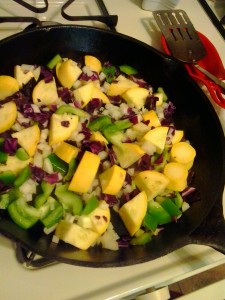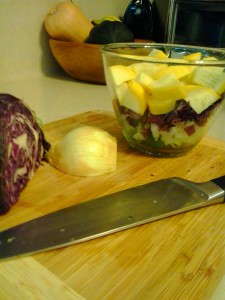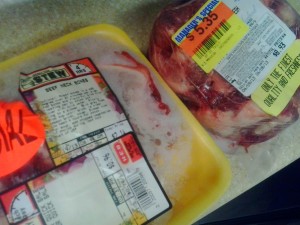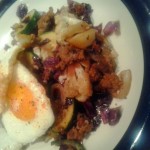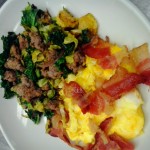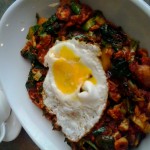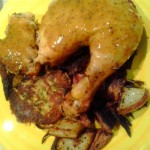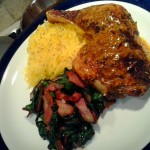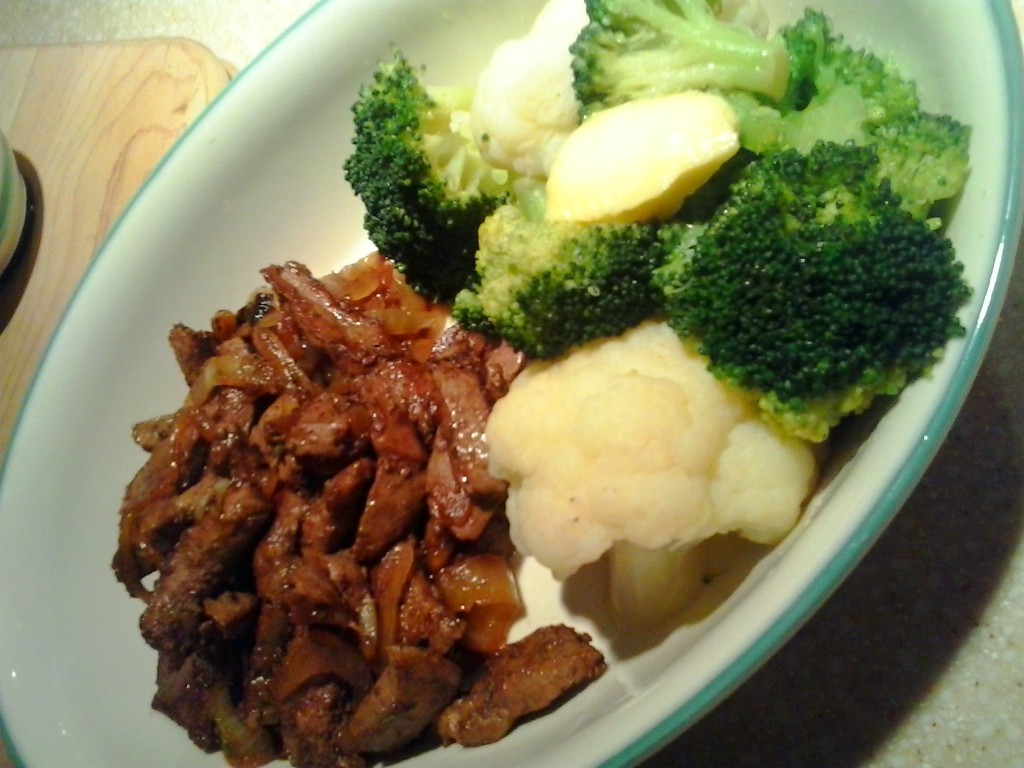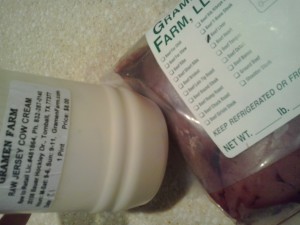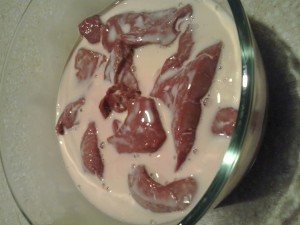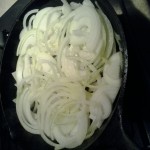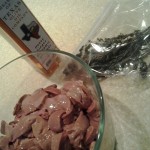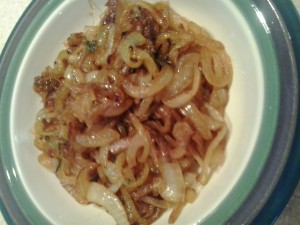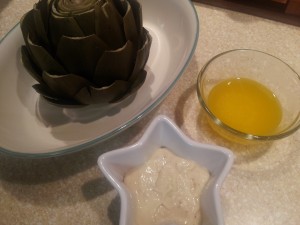In the last post, I wrote that I eat a lot of breakfast-oriented meals, usually around breakfast time, but I’m not particularly opposed to eating them other times besides the morning. I thought it would be informative to give a detailed breakdown of how I put together a quick & easy breakfast meal that will sets my day up for favorable metabolic processes. Therefore, giving you the “how” & the “why”.
HOW
So!, my normal outline for a breakfast meal starts with bacon. It’s the quintessential breakfast food, right? I’ll tell you why later… Anyway, when I have bacon on hand, which is most of the time, I start frying the bacon in my trustworthy cast iron skillet. If I don’t have bacon, I start by scooping out some coconut oil into said skillet and get it heating.
During that time, I take in my morning liquids. First, I have a glass of clean water (getting harder to find these days :/) with a spoonful of Himalayan salt sole. You can find more information about that here or here, I highly recommend it! Then, I have a small glass of homemade kombucha which makes me feel really happy and lucky to have a little SCOBY sidekick that loves me. **For the record, I let my kombucha brew until the sugar content is very minimal and I don’t add any fruit juice or flavoring to it. I like it just how it is, which is delicious!**
At this point, I am also chopping vegetables and retrieving any protein I may use in my upcoming breakfast dish. When the bacon is done I let it sit for a second then I usually eat it while cooking the rest of breakfast. It is basically like my breakfast appetizer. I may drain off some of the bacon fat, if necessary, otherwise, I cook my veggies and meat in it. The next step is browning any additional meat. My normal choices are grass-fed ground beef, chorizo, pastured pork sausage, or natural chicken sausage. I brown the meat with some sea salt until it is just about cooked through then remove it from the skillet and put it in a bowl/similar device close by. Then, I add an array of veggies to the hot fat.
I like to incorporate some type of leafy green whether it be spinach, kale, brussels sprouts, cabbage, chard, etc. <—- Those are my favorites though. I pair that with a mix of whatever I have on hand such as onion(always), squash(summer or zucchini), bell pepper, mushrooms, broccoli, cauliflower and garlic. **I don’t advise adding potatoes to this unless you are super active or trying to gain weight. In which case, they are still not essential, just delicious.**
Heartier vegetables go in the skillet first such as onion, broccoli, cabbage & brussels. Depending how large you cut the squash and bell pepper, they can go in there with the first round. If smaller, they have a medium cooking time and should be put in a little later. This is also the time to add seasonings to your liking along with a healthy pinch of good salt.
As hearty vegetables are getting close to your desired doneness, add softer veggies like kale, spinach, mushrooms and garlic. Sometimes, at this point, I cover the skillet and let a little steam action occur. During this last stretch, I get out a different pan to cook my eggs in and get that heating with a little fat…because cast iron & eggs aren’t best friends from what I have experienced.
For the last minute, add meat back in with veggies to warm & incorporate. Also, start frying your egg/s. I usually have two sunny side up because they’re pretty and give the most runny egg yolk, yum!
Plate up the veggie & meat mixture then add eggs on top or on the side. If you’ve seen my photographs, I like the eggs on top so that the egg yolk runs down and acts like a sauce. It usually ends up looking something like so…
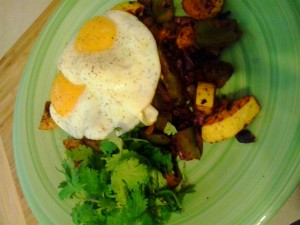
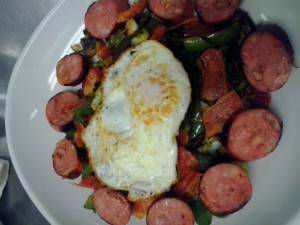 If you are an extra smart cookie, you would add a fermented condiment here such as sauerkraut or a pickle of sorts. I’m just hoping I get most of my probiotics from the kombucha. I also take a probiotic supplement because I’m a bacteria freak, seriously, they are SO cool. I wouldn’t mind studying microbiology for a long time. On a tangent, I watched Terry Wahl’s Ted talk yesterday and she said that had we not evolved to have mitochondria, we would still be the size of bacteria. It blew my mind.
If you are an extra smart cookie, you would add a fermented condiment here such as sauerkraut or a pickle of sorts. I’m just hoping I get most of my probiotics from the kombucha. I also take a probiotic supplement because I’m a bacteria freak, seriously, they are SO cool. I wouldn’t mind studying microbiology for a long time. On a tangent, I watched Terry Wahl’s Ted talk yesterday and she said that had we not evolved to have mitochondria, we would still be the size of bacteria. It blew my mind.
WHY
Now, why should you eat like this in the morning or for your breaking the fast meal?
First and foremost, it is important to understand that during the night we eventually run out of glucose and must rely on our energy stores to keep the body functioning. To keep blood sugar levels stable, we call upon our fat stores and some protein to carry out gluconeogenesis and ketogenesis. Either way, the body is burning fat. The body is a fat burning machine!
Therefore, you wake up in the morning… you are in a fasted state, cortisol levels are high, insulin levels are non-existent… your body is burning fat… what should you do? From the wise words of John Kiefer of Carb-Backloading, whom I was lucky to see at Paleo FX’13, “Don’t screw it up by eating carbs!!!!”
Keep the fat-burning roll going by eating fats(bacon, coconut oil, avocado), protein(meat,eggs), vegetables, nuts, seeds AKA anything besides carbohydrates and sugar. Yes, this includes fruit. **Fruit doesn’t necessarily spike blood sugar levels but it does have an effect on insulin. Fructose, the primary carbohydrate in fruit, must go through the liver to be processed and when it does, glucose is released in a prolonged, steady stream which contributes to a stream of insulin in accompaniment. This translates to a longer period before the body can have access to it’s fat stores again.**
HORMONE TALK
If there is an intake of carbohydrates (sugar, bread, potatoes, chips, corn, tortillas, pastries, beans, flour, etc.), insulin in the blood will soon follow. Insulin signals the off switch to your favorable fat burning state into a carbohydrate burning, fat storing state. Eat carbs + release insulin = glucose into your fat cells, AKA fat storage.
The effects of insulin are even worse in the morning when cortisol levels are at their highest because cortisol attempts to block insulin’s effects. In the absence of carbohydrates and insulin, cortisol naturally pushes for fat burning (GOOD!) but, all three together result in elevated blood sugar for a prolonged period of time. Therefore, the body keeps pumping out insulin in response to blood glucose levels but its effects are inhibited until cortisol lets off. When it does, the body gets a massive hit of insulin & glucose and fat storage occurs.
The body doesn’t do well with elevated blood glucose or high insulin levels, they are extremely inflammatory. Inflammation is like static on a TV, making signaling more difficult. This leads to a host of miscommunication through the body such as leptin resistance.
Leptin tells the brain that you have had adequate food and you are satisfied. What if the brain couldn’t interpret that message? You would be hungry all the time– not good. Glucagon, the opposing hormone to insulin signals the fat burning processes to begin again, YAY! Glucagon and insulin can never use their signaling power at the same time and insulin gets precedence, always. So, anytime carbohydrate is consumed and insulin is released, the body will not have access to energy from its fat stores until insulin has completely subsided(~2 hours).
By this time, you will probably be ravenous and reach for more carbohydrates, perpetuating the cycle. **Insulin kind of sucks in its response to carbohydrate intake. But, there is no such thing as a “bad hormone”. It actually has many other uses and contrary to common belief, lowering blood glucose is not its main purpose…. we just eat too much sugar and made it that way! Now it’s a fact in the textbooks…**
TAKE AWAY
– Eating carbs for breakfast screws up circadian rhythms(hormone cycles), stops your fat burning fast, signals the body to store fat & contributes to inflammation.
– Eggs, bacon, meat & veggies are traditional breakfast foods that won’t contribute to fatness under the correct hormonal conditions(absence of insulin).
– Although I wrote a life story for my breakfast routine, all of that happens in twenty minutes or less and it’s really easy.
– Hormones are pretty complicated and require a lot of studying, but, they run the show and it is in your best interest to figure them out past what I have stated here.
Now that you are enlightened, you can feel good about your breakfast choices! Downside: now that you know, you can’t unlearn this information. Doughnuts and sugary coffee for breakfast is pretty catastrophic, SORRYS!
Additional info that I used for this post:
http://www.prweb.com/releases/carb-back-loading-review/john-kiefer/prweb10343885.htm
http://www.dietriffic.com/2012/12/04/carbs-at-night/
http://www.seanhyson.com/blog/carb-backloading-qs-kiefer-as-part-i
http://robbwolf.com/2012/11/27/kiefer-carb-backloading-episode-160/



 May 11th, 2013
May 11th, 2013  Jessica Kistler
Jessica Kistler 
